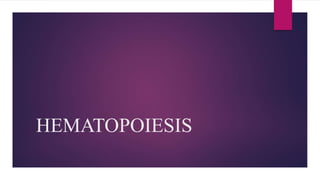
HEMATOPOIESIS - formation of blood cells
- 2. HEMATOPOIESIS Hematopoiesis is the process of formation of blood cells in the body, occurring primarily in the bone marrow. This process includes the production of Red blood cells, White blood cells, Platelets The term hematopoiesis originates from Greek, hemato (BLOOD) and poiesis meaning (PRODUCTION or FORMATION)
- 3. SITE OF ERYTHROPOIESIS (IN FETAL LIFE) 1. Mesoblastic Stage: During first two months of intrauterine life, RBCs are produced from mesenchyme 2. Hepatic Stage: From third month of intrauterine life, liver is the main organ that produces RBCs 3. Myeloid Stage: During last three months of intrauterine life, the RBCs are produced from red bone marrow and liver
- 4. SITE OF ERYTHROPOIESIS In newborn babies, children and adults: RBCs are produced from the red bone marrow 1. Up to age of 20 years: RBCs are produced from red bone marrow of all bones (long bones & all flat bones) 2. After age of 20 years: RBCs are produced from membranous bones like vertebra, sternum, ribs, scapula, iliac bones & skull bones and from ends of long bones
- 5. CELLULAR PATHWAY OF HEMATOPOIESIS STEM CELLS PROGENITOR CELLS PRECURSORS CELLS EFFECTOR CELLS
- 6. STEM CELL Stem cells play a crucial role in hematopoiesis, Hematopoietic stem cells (HSCs) are multipotent stem cells found in the bone marrow that can differentiate into various types of blood cells, including red blood cells (erythrocytes) white blood cells (leukocytes) and platelets (thrombocytes). These stem cells have the remarkable ability to self-renew, ensuring a constant supply of blood cells throughout life. They are essential for maintaining the body's immune system and ensuring proper oxygen transport, clotting, and defense against infections.
- 7. PROGENITOR CELLS In hematopoiesis, progenitor cells are intermediate cells derived from hematopoietic stem cells (HSCs) and give rise to specific blood cell lineages. Here are the main progenitor cells involved: Myeloid Progenitor Cells: Common Myeloid Progenitor (CMP): Gives rise to erythrocytes (red blood cells), platelets, granulocytes (neutrophils, eosinophils, basophils), and monocytes/macrophages. Megakaryocyte-Erythroid Progenitor (MEP): Differentiates into megakaryocytes (which produce platelets) and erythrocytes. Granulocyte-Monocyte Progenitor (GMP): Produces granulocytes (neutrophils, eosinophils, basophils) and monocytes (which become macrophages upon migration into tissues).
- 8. CONT. Lymphoid Progenitor Cells: Common Lymphoid Progenitor (CLP): Gives rise to lymphocytes, including T cells, B cells, and natural killer (NK) cells. These progenitor cells undergo further differentiation and maturation steps under the influence of various growth factors, cytokines, and microenvironmental cues in the bone marrow niche. This process ensures the continuous production of all types of blood cells to maintain homeostasis and respond to physiological needs and challenges.
- 9. PRECURSORS CELL In hematopoiesis, precursor cells are intermediate stages of differentiation between progenitor cells and fully mature blood cells. These precursor cells are committed to a specific lineage and undergo further maturation to become functional blood cells. Here are some key precursor cells involved in hematopoiesis: Proerythroblasts: Precursors of red blood cells (erythrocytes). They contain cytoplasmic hemoglobin and gradually decrease in size as they mature. Megakaryoblasts: Precursors of platelets (thrombocytes). They undergo a process of endomitosis to become polyploid megakaryocytes.
- 10. CONT. Myeloblasts: Precursors of granulocytes (neutrophils, eosinophils, basophils). They exhibit prominent nucleoli and a high nuclear-to- cytoplasmic ratio. Monoblasts: Precursors of monocytes, which mature into tissue macrophages. They have a less condensed chromatin compared to myeloblasts. Lymphoblasts: Precursors of lymphocytes (T cells, B cells, natural killer cells). They undergo rearrangements of their antigen receptor genes during maturation.
- 11. EFFECTOR CELLS In hematopoiesis, effector cells are fully differentiated blood cells that perform specific functions within the bloodstream or tissues. Here are the main effector cells in hematopoiesis: Erythrocytes (Red Blood Cells): Responsible for oxygen transport from the lungs to tissues and carbon dioxide transport from tissues to the lungs. Lack a nucleus and most organelles, allowing for maximum space for hemoglobin, the oxygen-carrying protein. Platelets (Thrombocytes): Essential for blood clotting (hemostasis) to prevent excessive bleeding. Form clots at the site of vascular injury, sealing the damaged blood vessel and initiating the repair process.
- 12. CONT. Granulocytes: Neutrophils: First responders to bacterial infections. Engulf and destroy bacteria through phagocytosis. Eosinophils: Involved in allergic reactions and defense against parasitic infections. Release toxins to kill parasites and modulate allergic responses. Basophils: Release histamine and other mediators of inflammation. Contribute to allergic reactions and inflammatory responses Monocytes/Macrophages: Monocytes circulate in the bloodstream before migrating into tissues, where they differentiate into macrophages. Macrophages are involved in phagocytosis, antigen presentation, and tissue remodeling. Play key roles in immune defense, wound healing, and maintaining tissue homeostasis.
- 13. CONT. Lymphocytes: T Cells: Involved in cell-mediated immunity. Recognize and eliminate infected or abnormal cells and regulate immune responses. B Cells: Responsible for humoral immunity. Produce antibodies (immunoglobulins) that neutralize pathogens and mark them for destruction. Natural Killer (NK) Cells: Provide rapid responses against virus-infected cells and tumor cells. Induce apoptosis (cell death) in target cells.
- 18. Lymphocytes are involves in the production of new lymphocytes, including B lymphocytes, T lymphocytes, and natural killer (NK) cells. B lymphocytes primarily produce immunoglobulins, also known as antibodies, and are key effectors of humoral immunity. Life span = average lifespan of a week to a few months, but some live for years.
- 20. REFERENCE https://www.slideshare.net/LadiAnudeep/hematopoiesis-70137084 https://www.slideshare.net/amenullah1/hematopoisis https://my.clevelandclinic.org/health/articles/24287-hematopoiesis https://www.medicalnewstoday.com/articles/319544